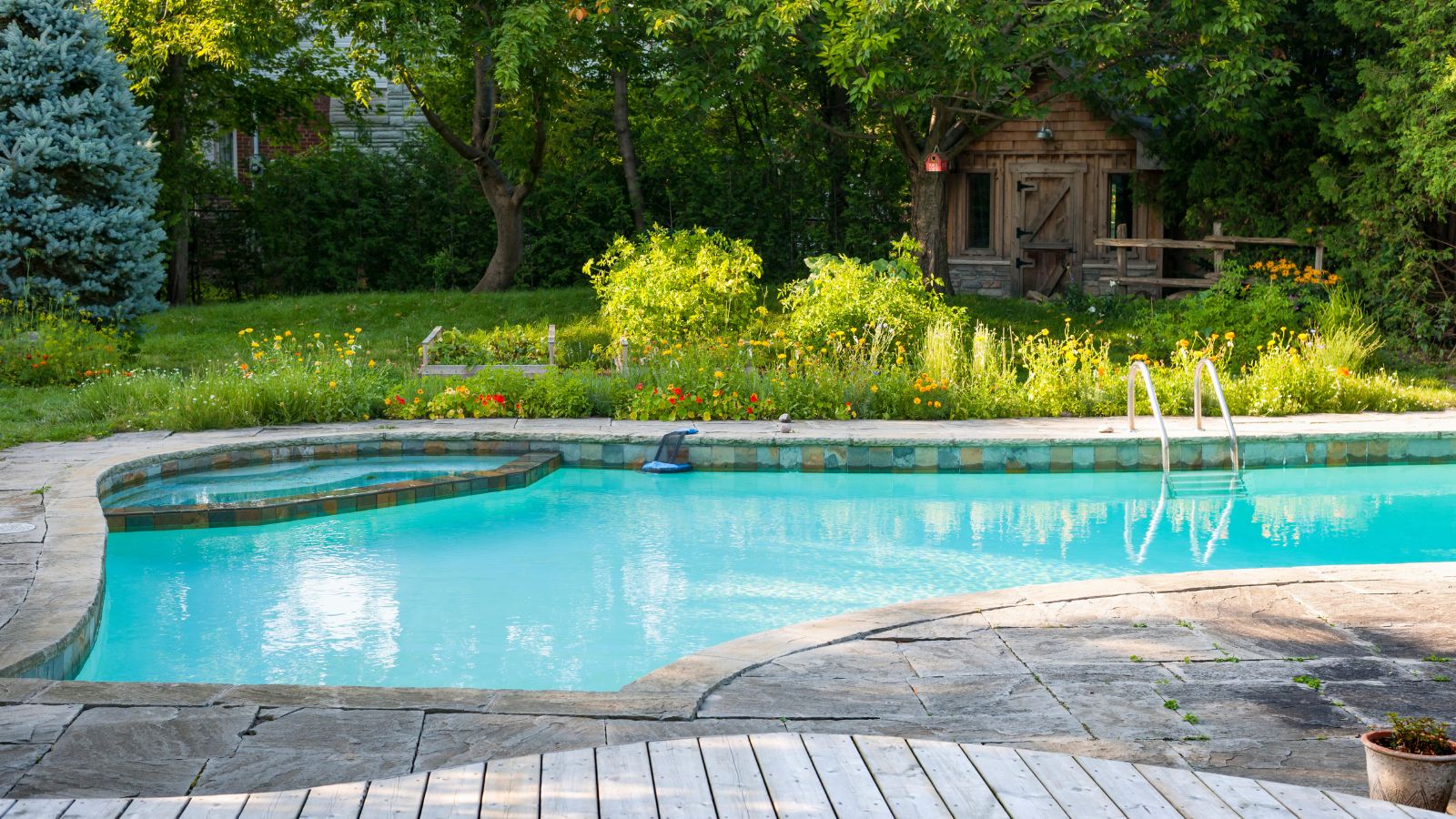Can I drain my pool water on the lawn? Lawn and pool experts advise on best practice
Need to drain your pool but don't want to damage your grass? We have expert tips to ensure no harm will come to your lawn if you drain your pool water on to it


Whether you have a permanent swimming pool setup or a child's paddling pool, you might be wondering if you can drain your pool water on to the lawn without damaging it.
The easiest solution might also seem like the most practical. After all, emptying pool water on to a lawn could also be a good way to water the grass, right?
However, if your pool's water is chlorinated or salted, it could well damage the lawn and surrounding plants. That doesn't mean you absolutely can't drain pool water on to a lawn – we've spoken to lawncare experts to get the lowdown, including when the best time to water your lawn is.
Can I drain my pool water on the lawn without damaging grass?
The answer, in short, is yes provided you take certain precautions. Most of the time emptying chlorinated pool water should cause little-to-no damage to your lawn so long as the chlorine is diluted.
However, you should avoid emptying pool water onto the lawn too frequently, and the smaller the amounts at any given time, the better.
Also, if the chlorine levels in the pool are too high then this may lead to a pH imbalance in your soil, causing your grass and surrounding plants to die. To avoid this there are a few steps you should take to ensure the chlorinated water is at a safe level to drain onto your lawn.
Why can draining a pool cause damage to grass?
Soil can survive chlorine at high acid levels, meaning that the chlorine won't remove the nutrients needed for grass to thrive. But to be safe, we recommend checking the chlorine levels in your pool before draining. If the chlorine levels are too high you may need to dilute the water more before draining.
Design expertise in your inbox – from inspiring decorating ideas and beautiful celebrity homes to practical gardening advice and shopping round-ups.
An issue with draining large amounts of pool water, however, is the danger of 'drowning' your grass. Another undesirable consequence of this may also include drainage issues, causing flooding, which can attract nasty pests such as mosquitoes.
Miguel Camperos, VP of Operations of Virginia-based gardening company SunVara suggests when it comes to draining pool water 'you should only drain as much pool water as your lawn can absorb. This is usually about 1-1.5 inches of water per week for most lawns. Overwatering – or in this case, draining out more water from your pool than your lawn can handle – can lead to waterlogging your lawn and can damage the roots of the grass.'
How to minimize damage to your lawn when draining a pool
Before draining your pool it's important to check the chlorine levels in your pool, which can be done by using pool test strips from Amazon. Safe pH levels that won't damage grass or nearby plants will be between 7.0 and 7.8.
To reduce the risk of harming your grass and to lower pool chlorine levels, stop adding chlorine or any other chemicals to the pool for several days before draining to ensure the chemicals are properly diluted. Leaving the pool uncovered and the water exposed to sunlight can also help dissolve the chlorine.
If your backyard is on a level surface you should be wary not to drain pool water on to the lawn all at once, since if the water has nowhere to travel before soaking into the ground there is a risk that flooding may occur, which can ultimately cause the grass to suffocate, leading to lawn damage.
If possible, alternate where the water is drained. If you have more than one drainage hole in the pool, changing which one you use can reduce damage. Or, a better solution would be to use a method of transferring where your water is drained, such as a hose.
Zahid Adnan gardening expert and the founder of The Plant Bible provides his insight into the amount of water to empty without harming the lawn: 'It's important not to flood the lawn by emptying large amounts of water at once. Gradual and controlled emptying is recommended. Start with small increments and observe how well the lawn absorbs the water before adding more. This allows the soil to absorb the water effectively without oversaturating it.
'Observe the lawn for any signs of overwatering or stress. If you notice water pooling or signs of water stress on the grass, adjust the amount of water you're emptying onto the lawn.'
Lawn expert Ryan Farley, CEO of LawnStarter agrees: 'It's best to distribute the water around different areas of your lawn to avoid waterlogging and suffocating the roots of your grass.
'When draining your pool, the water should be released slowly and evenly across your lawn to prevent flooding. You may need to drain it over several days or weeks, moving the hose to a different area of your lawn each day.'
Where best to empty pool water?
To avoid issues such as flooding and drowning the roots of your grass, and causing root rot, pools should ideally not be emptied onto flat ground where there is nowhere for the water to drain.
Grass, stony or rocky areas in your garden are likely to be your best option since they allow the water to filter away through soil.
You should also investigate the groundwater levels local to you. If they are high, you should consider emptying your pool bit by bit over time.
Zahid Adnan gardening expert and the founder of The Plant Bible advises that 'If your lawn has poor drainage, be cautious about adding excessive water as it can lead to waterlogging and adversely affect the health of the grass.'
When is the best time to drain your pool?
The best time to water your lawn in order to make the most of your pool water without harming your grass, is, agree experts, during the cooler parts of the day – this means the early morning or evening. However, consensus seems to generally be that in hot summer weather, the evening is the best time to allow the water to soak in before it can quickly evaporate in sunlight.
As for seasons, spring is often the best time to drain your pool when the temperature is under 85°F. Winter is not optimal since the chance of heavy rain and flooding after draining your pool is more likely, which can be costly to the health of your lawn and lead to algae, moss and fungus developing.
In summer, when your soil is more likely to be drier and harder for the water to penetrate your grass, flooding and lawn-drowning are more likely, meaning summer is also not the most optimal time to drain your pool.
Can I water my lawn with pool water?
Using pool water, if done correctly and especially in summer, can be a handy way of saving both money and water. Gary Clarke, Garden Renovation Consultant at Green Thumb Lawn Treatment Center suggests: 'Keep it moderate, monitor, and time it right! Dechlorinated pool water in moderation can do wonders, but it’s crucial to watch your lawn’s response.'
You might assume that you should water the lawn at night, which makes sense in very hot weather. But be aware that lower temperatures and lack of sunlight may mean the water will take longer evaporate, meaning the lawn will stay damp for longer. This can increase the possibility of fungus developing, which is counterproductive to using the pool water to improve your lawn's health.
Matthew Koch, Ph.D., Director of Biotechnology, Genetics, Lawn Nutrition and Seed at Scotts recommends watering your lawn in the early morning or evening to make the most of the water used.
Zahid Adnan gardening expert and the founder of The Plant Bible suggests, 'it's generally best to empty the pool water onto the lawn during the cooler parts of the day, such as early morning or evening. Watering during these times minimizes evaporation and allows the lawn to absorb the water more efficiently.'
Matthew Koch adds that 'there are a couple things to consider when you’re looking to use pool water to water your lawn. It’s okay to use unsalted pool water occasionally to water your lawn, but it’s important not to use pool water that was recently treated with chlorine. If you want to use water from your unsalted pool, wait at least a few days after adding chlorine so it has had a chance to dissipate. Chlorinated water with too high of a concentration could cause damage to the lawn'.

Gary Clarke is a lawn care expert at Green Thumb, a company that carries out 2.5 million lawn treatments every year. With unrivaled expertise and a passion for gardening, Gary has inspired and guided numerous individuals in creating stunning outdoor spaces. Trust him to turn your garden dreams into reality.
What tools can be used to ensure pools are correctly drained?
Using a draining hose is an efficient and simple-to-use. We like the Blue Devil Hose from Amazon, an ideal tool for distributing and redistributing where the pool water is drained. This means that instead of staggering the draining process over time, you can do it all in one go, changing the positioning of the hose every once in a while.
The use of a drainage hose can also be a solution if draining water onto flat ground is an issue. The long hose can mean that you are able to drain the water in an area where the water can travel downhill or straight into a drain. If you are considering a drainage hose for this reason be sure to measure how far your hose would need to carry the pool water and find a draining hose that has the correct measurements for you.
FAQs
Can you drain salt water pools on to a lawn?
Large quantities of salt can damage your lawn. The key to avoiding this is dilute, dilute, dilute. Salt, unlike chlorine, can remain on your grass until it is next washed away, which may take a while in summer. Therefore, after draining the salt water, we recommend soaking the ground with fresh water to dissipate the salt.
Can I drain kiddie or pet pool water on my lawn?
You can empty a pet pool or a kiddie pool into your lawn, though as always you need to be aware of causing localized flooding of the lawn or nearby plants; also, if there's chlorine in the kiddie pool water, you need to ensure that the chlorine levels are diluted.
Draining pool water is something you need to consider carefully before installing your pool. It's worth noting that you are not allowed to drain water into the street, gutters or storm drains; instead, pool water should go into the sanitary sewer, if not on to your lawn.

Lola Houlton is a news writer for Homes & Gardens. She has been writing content for Future PLC for the past six years, in particular Homes & Gardens, Real Homes and GardeningEtc. She writes on a broad range of subjects, including practical household advice, recipe articles, and product reviews, working closely with experts in their fields to cover everything from heating to home organization through to house plants. Lola is a graduate, who completed her degree in Psychology at the University of Sussex. She has also spent some time working at the BBC.